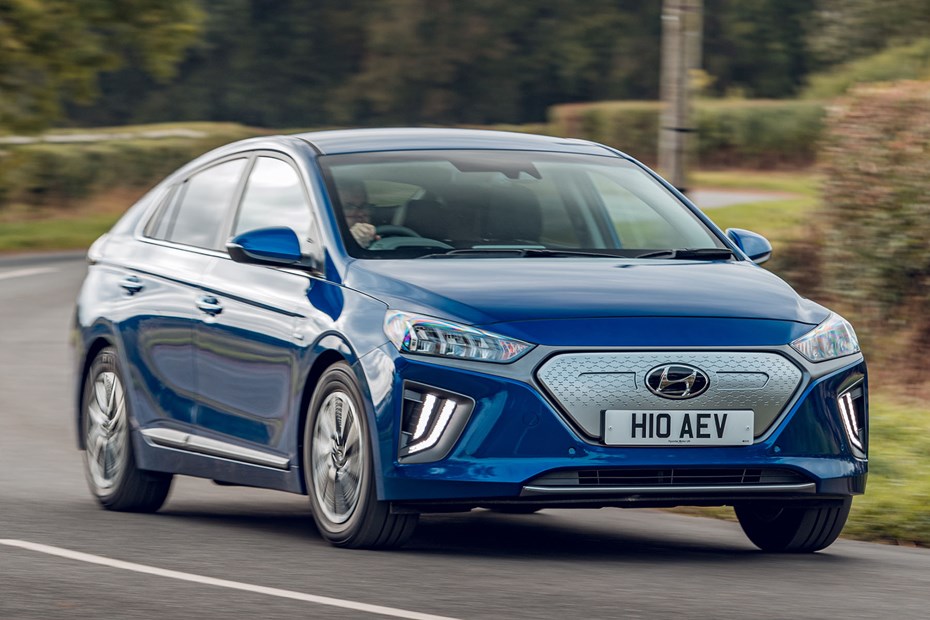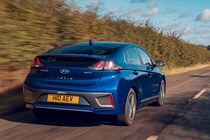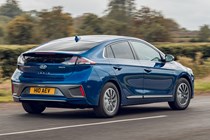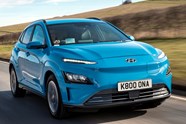
Hyundai Ioniq Electric Hatchback review

At a glance
| Price new | £30,750 - £34,050 |
|---|---|
| Used prices | £6,693 - £18,133 |
| Road tax cost | £0 |
| Insurance group | 16 - 17 |
Get an insurance quote with

|
|
| Fuel economy | 4.5 miles/kWh |
| Range | 193 miles |
| Miles per pound | 7.1 - 13.2 |
| View full specs for a specific version | |
Available fuel types
Fully electric
Pros & cons
- Near silent electric running
- Soft, pliant ride is a delight
- Five-year warranty
- A bit plain for some tastes
- Poor range for the money
- Below average finance deals
Hyundai Ioniq Electric Hatchback (16-22) rivals
Overview
Despite being an all-singing, all-dancing, electric car, the Hyundai Ioniq Electric was much more of an evolution than a revolution. That’s because it was a light facelift of an existing model. To look at, this one is not all that different to the first-generation Ioniq Electric, and neither is it that different to drive.
The reason for the Mk2 update was to improve its electric range, which was never that impressive in the current EV market. From full to empty, according to the latest WLTP figures, it’ll cover 193 miles. That’s a 36% increase compared with the old car. It is however, quite far behind other electric cars, most notably its sister car, the Kona Electric.
Rapid charging from a 100kW station will take the battery from zero to 80% in 54 minutes. A 7kW charger, like the ones you can get attached to your home, takes six hours and five minutes.
What are the best bits?
Flash-looking LED head and tailights, 16-inch alloy wheels, and slightly modified front and rear bumpers are the main visual differences for the new Ioniq Electric. Although that doesn’t amount to much, it does freshen up what is a unobtrusive-looking car, and one that won’t scare off those early adopters who, er, don’t want to look like early adopters.
The price has changed, too – although it’s still one of the more affordable EVs for your money. Premium-spec cars starts from £33,950, while top-spec Premium SE cars start from £35,950, although both are eligible for the £3,000 Government electric car grant.
What makes the Ioniq Electric so special?
Subtlety is a characteristic missing in many mainstream cars today, but luckily, the Ioniq Electric takes subtlety to new levels. Barring the rather odd-looking front grille and a few choice electric badges, it doesn’t look that different from the hybrid or plug-in hybrid model. If you want to keep it low-key, this really is the EV that will tick the boxes for you.
Inside, it’s a sea of subdued colours and well-trimmed fixtures. No, none of it particularly fills you with surprise and delight, but it’s well finished and organised sensibly. All of the controls look and feel like quality items, and don’t resort to gimmicks like in the Tesla Model 3. Would you be scared off by this car if clapping eyes on it for the first time? Of course not.
New for the Ioniq is a 10.25-inch infotainment screen. It’s mounted nice and high, and it’s easy to use. The only drawback is that the heating control panel is touch sensitive, which means it can be tricky to use on the move. Also new is Hyundai’s BlueLink app. This uses an embedded telematics system that allows owners to adjust the air con/heating, or lock/unlock their car remotely via an app on their smartphone.

What’s it like to drive?
First thing’s first; there’s no transmission to worry about. It’s just like an automatic to drive, but even simpler. There are D (for Drive) P (Park) and R (Reverse) buttons where you would normally find the gearbox, and that’s it. Click D, press the accelerator pedal, and you’re away in near silence.
The 0-62mph sprint takes 9.7 seconds. While far behind some electric cars, it’s still perfectly respectable. It’s just about the same pace as a 105hp 1.0-litre Volkswagen Golf and a little slower than an e-Golf. However, if you drove this and a 1.0-litre Golf back to back, however, you’d swear that the Ioniq was faster. This is because of how direct power delivery is – there’s no hesitation at all, it’s just press and go.
On our extremely flat test route in The Netherlands, the Ioniq and its 16-inch alloy wheels did a great job of cushioning you from bumps. The WLTP range of 193 miles seems achievable too.
On either side of the steering wheel, there are two hand operated paddles that control the regenerative braking. The left takes the level up, the right takes it down. This changes the ferocity with which the motor regenerates power back into the battery.
With full regeneration mode on, the car slows down much faster when you lift off the accelerator, like engine-braking in an older car. In most situations, with the regen at its top level, you could almost not use the brake pedal.
Noise levels are pretty good, although there is a bit of wind clamour, elevated by the lack of engine noise.
To find out how we rate the Ioniq Electric read on for the verdict.












